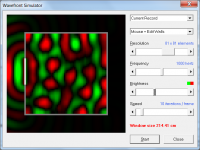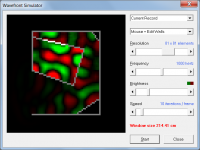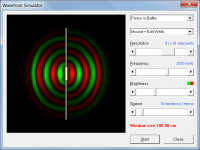(raising the difficulty level: you could also add the box resonances to the simulation 😀 )
Attachments
Very nice app! Is it possible to load an arbitrary model and simulate the response of the enclosure by their inherent properties (-> combined structural analysis/modal analysis) and the stimulation of the propagating wave of the diaphragm?
which Ansatz did you use ?
which Ansatz did you use ?
Last edited:
Hi WatrixReloader,
The Hornresp Wavefront Simulator tool is based on the falstad.com 2-D Ripple Tank applet.
Math, Physics, and Engineering Applets
It is possible to specify a custom enclosure and to simulate the propagating wave of the diaphragm - see the Wavefront Simulator section in the Hornresp Help file for details.
See the Ripple Tank applet source code for the assumptions underlying the simulation model.
Kind regards,
David
Very nice app!
The Hornresp Wavefront Simulator tool is based on the falstad.com 2-D Ripple Tank applet.
Math, Physics, and Engineering Applets
Is it possible to load an arbitrary model and simulate the response of the enclosure by their inherent properties (-> combined structural analysis/modal analysis) and the stimulation of the propagating wave of the diaphragm?
It is possible to specify a custom enclosure and to simulate the propagating wave of the diaphragm - see the Wavefront Simulator section in the Hornresp Help file for details.
which Ansatz did you use ?
See the Ripple Tank applet source code for the assumptions underlying the simulation model.
Kind regards,
David
Attachments
Last edited:
It is possible to specify a custom enclosure and to simulate the propagating wave of the diaphragm - see the Wavefront Simulator section in the Hornresp Help file for details.
The WaveFront Sim is a cool app. It would be nice though to be able to set the specific frequency for the sim, rather than having it being adjustable only in steps of 100Hz. For example, I'd like to see what's happening in my TH at around 160 Hz, where there's a dip in the frequency response...
For example, I'd like to see what's happening in my TH at around 160 Hz, where there's a dip in the frequency response...
Hi Brian,
The Hornresp Wavefront Simulator is a relatively simple tool - it shows how isophase wavefronts propagate and combine, but that is all.
For your purposes a more sophisticated finite element model than the one used in the Wavefront Simulator, would be required.
Kind regards,
David
Thx ....btw there are nice other simapps on this site 😀
Hi WatrixReloader,
The Hornresp Wavefront Simulator tool is based on the falstad.com 2-D Ripple Tank applet.
Math, Physics, and Engineering Applets
It is possible to specify a custom enclosure and to simulate the propagating wave of the diaphragm - see the Wavefront Simulator section in the Hornresp Help file for details.
See the Ripple Tank applet source code for the assumptions underlying the simulation model.
Kind regards,
David
A dip in the area around 160Hz is normally floor bounce when measured from 1m distance. To verify make two measurements, one half meter and another 1.5 - 2m distant.
A dip in the area around 160Hz is normally floor bounce when measured from 1m distance. To verify make two measurements, one half meter and another 1.5 - 2m distant.
This dip shows up in the HornResp sim, so it's not a floor-bounce effect.
- Status
- Not open for further replies.
- Home
- Loudspeakers
- Subwoofers
- Transmission line 'flow simulation'


